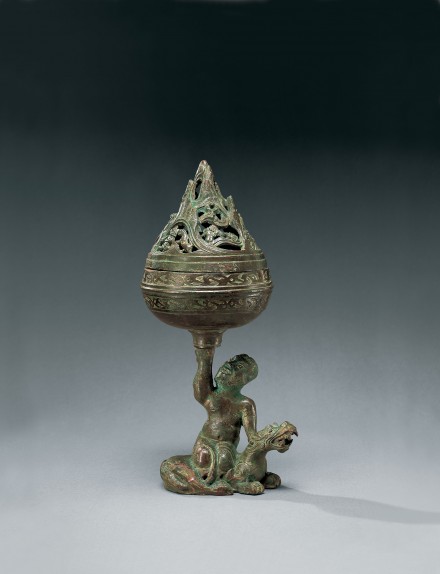J.J. Lally & Co., Oriental Art / New York City, New York
MenuPast Exhibition
Arts of Ancient China
March 27 - April 12, 2006

15.
A BRONZE BOSHANLU CENSER AND COVER ON FIGURAL BASE
Western Han Dynasty, late 2nd-1st Century B.C.
the base cast in the form of a man kneeling on the back of a recumbent dragon, leaning on the dragon’s neck with his left hand, gazing up towards his raised right hand which is fitted with a peg to receive the short socketed stem of the deep bowl of the censer, with an openwork mountain-shaped cover cast with numerous figures and animals in relief amidst swirling clouds, the stylized cliffs rising in tiers to a central peak, with apertures between the cliffs to allow the incense smoke to emerge, the many figures including a mountain-sprite thrusting his spear at a rearing tiger, a plump standing bear, a tiger attacking a unicorn, another tiger climbing in the clouds, a muscular mountain-sprite confronting a tiger, a traveler with an ox and cart, and a smaller seated bear, the edge of the cover fitted over the raised inner rim of the deep bowl-shaped censer, cast below the rim with two bands of intaglio cloud-scrolls separated by a narrow stepped girdle around the waist of the bowl, lightly engraved with two characters on the edge of the cover which may be read as bei yang and with the same two characters on the underside of the bowl, probably indicating the name of the owner, the surface with smooth dark green patination and scattered bright green corrosion in some recessed areas.
Height 9 5⁄8 inches (24.5 cm)
Compare the very similar bronze figural boshanlu censer with openwork cover, formerly in the collection of Mrs. Christian Holmes, now in the Nelson-Atkins Museum of Art, which was shown at the Royal Academy of Arts and illustrated in the catalogue, International Exhibition of Chinese Art, London, 1935-36, no. 394. The same piece is also illustrated by Fontein and Wu in Unearthing China's Past, Boston, 1973, p. 106, no. 45, where the authors mention a similar, slightly larger figural boshanlu of the same type in the Museum of Lushun, Liaoning province. Fontein and Wu also illustrate another similar boshanlu supported by the same type of strongman seated on an identical dragon raised on a dish-form base, from the tomb of Dou Wan, the wife of the son of the Han emperor Wudi, Liu Sheng, (died 113 B.C.), excavated at Mancheng, Hebei province, and now in the Hebei Provincial Museum, op.cit., p. 107, fig. 48.
Compare also the related openwork censer and cover held by a figure on a dragon-form base excavated in 1985 at Baoji city, Shaanxi province, now in the collection of Shaanxi History Museum, illustrated by Li Xixing (ed.) in The Shaanxi Bronzes, Xi'an, 1994, p. 353, pl. 318.
The boshanlu censer was an innovation of the Western Han period. The mountain-form cover on boshanlu censers is a representation of the ‘sacred mountains’ which in Han cosmology were regarded as an intermediary realm between heaven and earth. The high peaks of the ‘sacred mountains’ were a magic place where men encountered spirits and mythical beasts among the clouds. The term boshanlu can be traced back to the 4th century or earlier, but no particular Bo mountain can be identified in Chinese literature or geography, and the specific origin of the term remains a mystery. One traditional Chinese explanation is that the censer represents Mount Hua. It is said that the King Chao of Qin challenged the heavenly spirits to a game of liubo (a form of chess) on Mount Hua, and so in honor of this event, the mountain was given the name of (Liu) Bo Mountain (bo shan). Berthold Laufer in Chinese Pottery of the Han Dynasty, Rutland, Vermont and Tokyo, Japan, 1962, p. 193, suggested that the mountain represents Penglai, the magical realm of the Daoist Immortals. It has also been suggested that the mountain represents Kunlun, the cosmic mountain of China which was said to exist in a range of mystical mountains northwest of the Chinese frontier.
西漢 騎獸人物銅博山爐 高 24.5 厘米
15.
A BRONZE BOSHANLU CENSER AND COVER ON FIGURAL BASE
Western Han Dynasty, late 2nd-1st Century B.C.
Height 9 5⁄8 inches (24.5 cm)